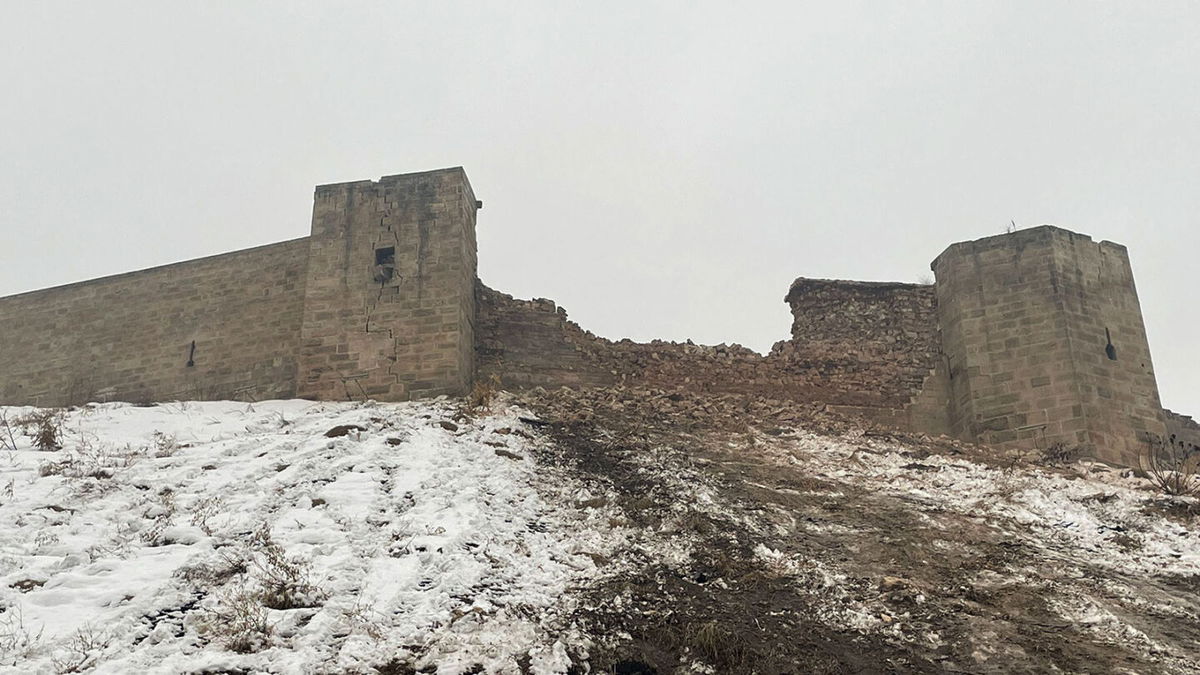UNESCO site ‘in danger’ faces greater peril after earthquake

A view of damaged Gaziantep Castle in Turkey on February 6
By Marnie Hunter and Mia Alberti, CNN
The devastating earthquakes in Turkey and Syria on Monday have damaged important historic sites, including the ancient city of Aleppo in northwest Syria which was already “in danger” from civil war.
The city, which was added to the the United Nations Educational, Scientific and Cultural Organization (UNESCO) World Heritage List in 1986, has been on the List of World Heritage in Danger since 2013 due to Syria’s ongoing conflict, along with five other sites in the country.
UNESCO said Tuesday it would provide assistance to damaged heritage sites in Syria and Turkey and offered condolences to the families of victims of the disaster.
The UN cultural organization was “particularly concerned” about the situation in the ancient city of Aleppo.
“Significant damage has been noted in the citadel. The western tower of the old city wall has collapsed and several buildings in the souks have been weakened,” UNESCO said in a press release.
Syria’s Directorate-General for Antiquities and Museums (DGAM) said in a Facebook post on Monday that the 13th-century citadel “suffered minor and moderate damage in which parts of the Ottoman mill fell, [there is] cracking and falling of parts of the northeast defensive fences. Large parts of the dome of the lighthouse of the Ayubi Mosque also fell, the entrances to the castle were damaged, and parts of the stone, including the entrance of the royal defense tower, and the front of the Ottoman refuge were damaged.”
The storied, ancient city of Aleppo was seriously damaged in the ongoing war, but after reconstruction work it reopened in 2018. DGAM says that artifacts inside the National Museum in Aleppo were damaged in Monday’s earthquake.
In Turkey, several buildings have collapsed at UNESCO site Diyarbakır Fortress and Hevsel Gardens Cultural Landscape, according to UNESCO. The site is an important center of the Roman, Sassanid, Byzantine, Islamic and Ottoman periods.
UNESCO said it has worked with its partners on an initial survey of damage to heritage sites and is in the process of compiling “a precise inventory of the damage with the aim of rapidly securing and stabilizing these sites.”
Other World Heritage sites close to the epicenter that could be affected include Göbekli Tepe, Nemrut Dağ and Tell of Arslantepe in Turkey, UNESCO said.
Damage extends beyond UNESCO’s list
Many cultural sites beyond the World Heritage list have also been damaged.
Gaziantep Castle, a historic site and tourist attraction in southeastern Turkey, suffered serious damage.
“Some of the bastions in the east, south and southeast parts of the historical Gaziantep Castle in the central Şahinbey district were destroyed by the earthquake, the debris was scattered on the road,” Turkish state-run news agency Anadolu reported.
“The iron railings around the castle were scattered on the surrounding sidewalks. The retaining wall next to the castle also collapsed. In some bastions, large cracks were observed,” the report said.
The dome and eastern wall of the historical Şirvani Mosque, which is located next to the castle and is said to have been built in the 17th century, also partially collapsed, it added.
According to archaeological excavations, the castle was first built as a watchtower in the Roman period in the second and third centuries C.E. and expanded over time.
It took its current form during the reign of Byzantine Emperor Justinian (527-565 C.E.), according to Turkish Museums, the official site of museums and archaeological sites in the country.
In Syria, DGAM also reports damage to historical buildings and mosques in the Hama Governorate in western-central Syria, such as cracks in the structure and collapsed walls in the Imam Ismail Mosque and the Shmemis Castle.
The Al-Marqab Castle, a Crusader fortress near Baniyas, in northwest Syria, also suffered damage, including the collapse of a block from one of its circular towers.
“The tremor also led to the fall of the rock cliff in the vicinity of the Qadous Castle and the collapse of some residential buildings situated in the castle’s campus,” DGAM said.
Experts are still studying the full extent of the damage to the historical sites and surrounding historical buildings and neighborhoods. DGAM said Monday it had not received “accurate information” about damage in the city of Homs.
The-CNN-Wire
™ & © 2023 Cable News Network, Inc., a Warner Bros. Discovery Company. All rights reserved.
CNN’s Lilit Marcus contributed to this report. Top image: The citadel in Syria’s ancient city of Aleppo was damaged in the February 6, 2023, earthquakes. (AFP via Getty Images)
